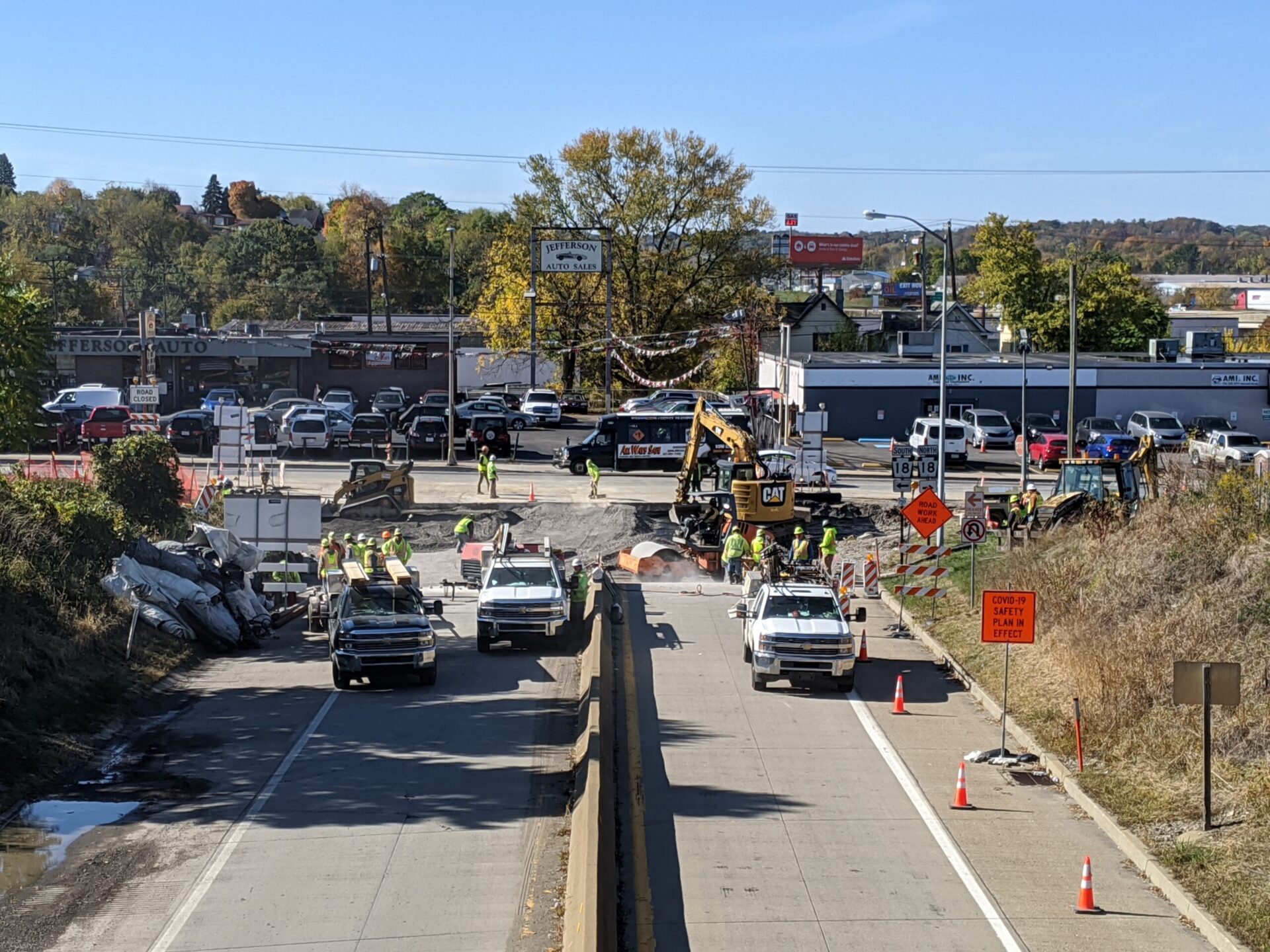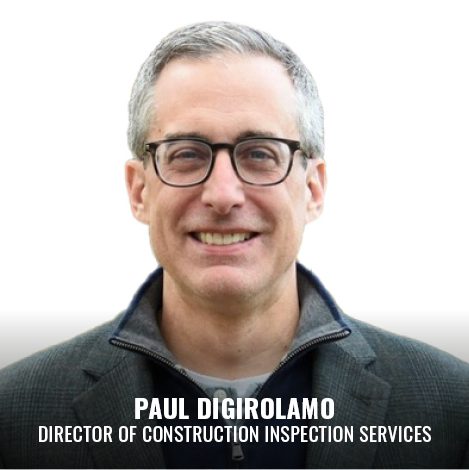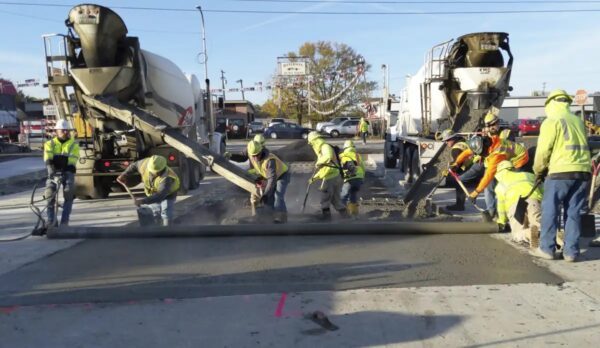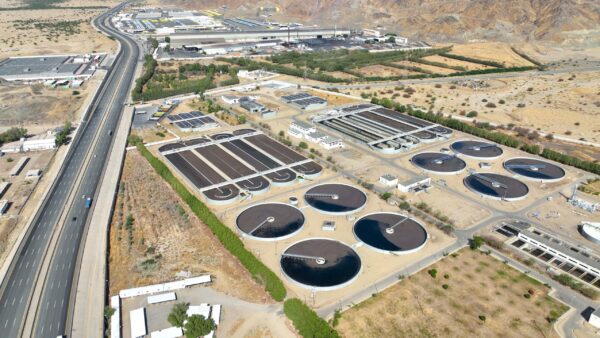

Hill International was honored with the 2024 PennDOT District 12-0 Golden Boot Award for the team’s contributions to the Route 18 Signal Upgrade project in Washington, PA. Together with the Pennsylvania Department of Transportation (PennDOT) District 12 and Tri-State Design, Hill was recognized for innovative solutions, excellent customer service, and the ability to deliver quality work on time and within budget. The Hill team provided construction inspection services to support the upgrade, staffing field supervisors, inspectors, and office management professionals.
In the spring of 2020, as the world began to grapple with the COVID-19 pandemic, PennDOT initiated a significant infrastructure upgrade for the local roads surrounding Interstate 70 (I-70) at Exit 17 in Washington, PA, a suburb of Pittsburgh. The Route 18 Signal Upgrade project reconstructed portions of connecting roads, including Jefferson Avenue (Route 18), Wylie Avenue, Henderson Avenue, and the I-70 Eastbound and Westbound ramps, improving road safety and efficiency. The project was part of PennDOT’s Connects program, which promotes community collaboration in transportation planning.
Project components included road resurfacing for improved durability and the addition of pedestrian-friendly features like sidewalks, ADA-compliant ramps, bus shelters, and pedestrian crossings. Roadway reconstruction comprised of utility replacement and coordination, drainage improvements, resurfacing of the city parking facilities, and new concrete ramps and bituminous roadways. Work also entailed replacing three traffic signals and installing two new signalized intersections.
As COVID-19 impacted the Pittsburgh region, Hill and PennDOT quickly implemented pandemic mitigation plans at the jobsite, confirming safety precautions and health guidelines were in place. Despite this added layer of complexity, the Hill team consistently delivered high-quality inspection services and worked closely with PennDOT to adhere to restrictions while moving the work forward.
Continuity of Service and a Phased Approach
A significant project challenge was managing the extensive utility work, which required a time extension. To address these delays, the project team implemented detailed field tracking and rigorously reviewed the Critical Path Method (CPM) schedule to maintain an efficient and realistic timeline for completion. Ultimately, the team assisted in rearranging the order of the 11 phases included in the contract to minimize traffic disruptions and impacts on the community.

“Our collaboration with PennDOT and our partners JMT and Michael Baker International really helped to reassess and reorder these phases to reduce the time extension caused by the utility delays,” says Hill Resident Engineer Carissa Traill. “This not only lessened impacts, but also helped control overall project costs.”
In addition to Hill’s emphasis on collaboration, the team’s ability to offer continuous inspection services through the phased, long-term project plan was critical to the project’s success. By deploying long-term inspectors with deep knowledge of the project, the team maximized work productivity and efficiency. Hill’s inspectors also combined fieldwork with office tasks, such as using iPads for on-site documentation while conducting inspections, further contributing to the project’s efficiency.
Creative Cost and Resource Management
Cost and resource management were also key to success. Hill assisted PennDOT with weekly inspection staff scheduling, optimizing the allocation of inspections while delivering high-quality service. Scheduling was flexible, allowing for daily adjustments to respond to changing needs due to contractor activities, utility work, or weather conditions.
Additionally, Hill worked with PennDOT to track and adjust inspection costs monthly, aligning costs with project requirements and budget constraints. This careful monitoring and management of costs were crucial in keeping the project within budget while still delivering the work as planned.

“The collaborative efforts of Hill and PennDOT in maintaining quality, maximizing resources and controlling costs, and adapting to dynamic project needs and conditions were instrumental,” says Paul DiGirolamo, Hill’s Director of Construction Inspection Services. “The team maintained this level of flexibility and creativity from the start, and it has really gone a long way.”
Partnership in Action
Partnership was the common denominator for managing field challenges and maintaining the project schedule, requiring strong collaboration alongside PennDOT. This encompassed Hill and Tri-State Inspection providing inspection services, JMT for design support, and Michael Baker International for schedule review.
“What really made a difference was the joint inspection services of Hill and Tri State, especially during extended night shifts and weekend shutdowns,” adds Paul. “The team effort pushed us forward, allowing us to make progress even outside standard working hours.”
A notable example of teamwork was when Hill’s inspectors discovered conflicts between the proposed drainage system and existing utilities during night shifts, requiring quick and coordinated action. Hill liaised with PennDOT and JMT to devise a plan to minimize schedule disruptions for the contractor, Plum Construction. In response, JMT made multiple plan revisions based on Hill’s detailed documentation. The Hill team’s role was also key to obtaining approvals for these revisions from the utility companies, keeping the project on track.
Prioritizing the Public
Throughout project execution, the team remained committed to the community. The team also maintained a high level of transparency and community engagement. Hill worked with JMT to regularly update the project website with information and progress photos. Working with PennDOT, the Hill team proactively engaged with residents, facilitating onsite meetings to address concerns and identify solutions and integrating community input into the project.
The team also prioritized ADA compliance and pedestrian safety. This included maintaining sidewalk access in downtown Washington, a heavily trafficked pedestrian area, and implementing safety measures like temporary construction fences, barriers, and signal crossings at intersections. In addition, Hill provided inspection services over multiple years, including day and night shifts as well as weekend shutdowns, to safely accommodate the large volume of pedestrian and vehicle traffic.
A Testament to Teamwork

Hill’s approach to employing multiple inspectors working various hours, while maintaining high-quality inspection services, provided the continuity necessary to keep the work moving. The broader team’s ability to creatively adapt to delays and field changes in a timely and cost-efficient manner while leveraging the expertise of each partner firm played a crucial role as well, demonstrating flexibility and collaboration in handling unforeseen challenges.
“Maintaining a comprehensive work history and meticulous meeting minutes, particularly over multi-year initiatives, was invaluable for managing discussions about time extensions and liquidated damages at the project’s conclusion,” shares Carissa. “Early assessment of design conflicts was also essential to minimize schedule disruptions and prioritize the needs of the community during a time when there was a lot of uncertainty.”
“I’m proud of this team’s talent and commitment to our client,” says Paul. “My advice for teams embarking on similar multi-phase projects is to build a consistent team, maintain detailed project records, and quickly and collaboratively address client needs and concerns. This approach facilitates smooth project execution and strengthens client relationships and trust. This work was a true testament to that.”
Share

June 23, 2025 | Articles
Jeffrey Hurley Joins Hill’s Northern California Rail Practice

June 23, 2025 | Articles
Ready, Set, Grow: First VP Chad Koelling Takes Charge of Hill’s Mountain West Region

June 8, 2025 | Articles
PMO in Saudi Arabia: The Holistic Approach to Realizing a National Mega-Portfolio

June 1, 2025 | Articles

May 26, 2025 | Articles

May 12, 2025 | Articles
Keeping Your Water/Wastewater Programs Flowing with Public Relations

April 27, 2025 | Articles
Oiling the Machine: Steps to Successful Permitting on Infrastructure Megaprojects

April 20, 2025 | Articles
Sustainable Scaling: Solutions for Managing Risk on Europe’s Data Center Projects